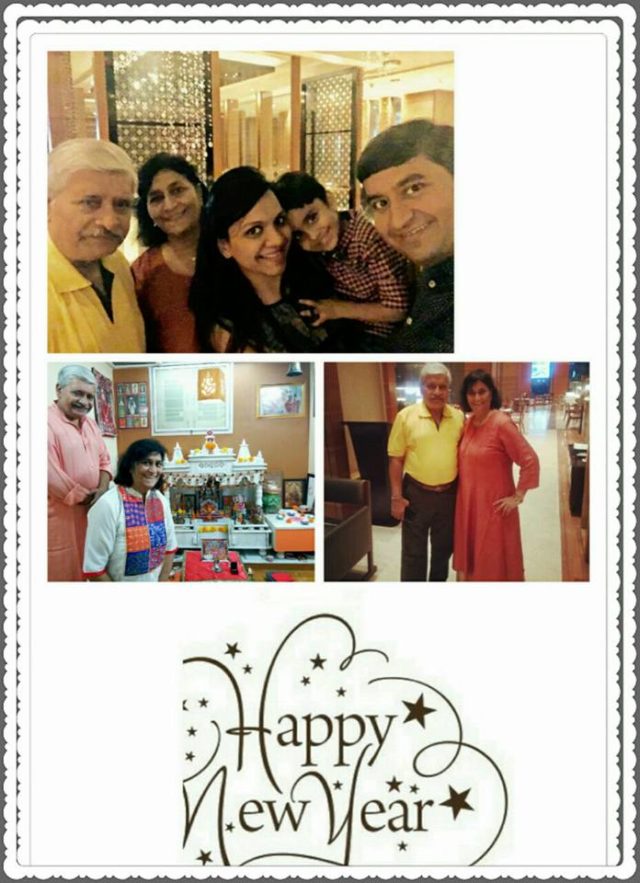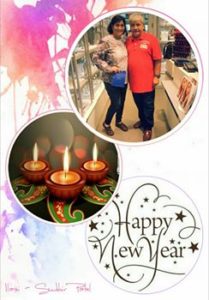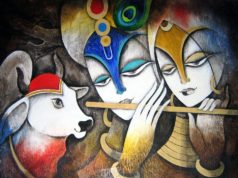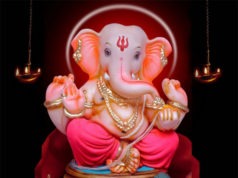Diwali, the festival of lights is celebrated all over India with enthusiasm. This Diwali which leads us into Truth and Light is celebrated on Amavasya – the 15th day of the dark fortnight of the Hindu month of Kartik (October / November) every year. It symbolizes that age-old culture of our country which teaches us to vanquish ignorance that subdues humanity and to drive away darkness that engulfs the light of knowledge. Diwali, the festival of lights even to-day in this modern world projects the rich and glorious past of our country and teaches us to uphold the true values of life.
“Deepavali” is a sanskrit word — Deepa meaning light and Avali, meaning a row. It means a row of lights and indeed illumination forms its main attraction. Every home – lowly or mightly – the hut of the poor or the mansion of the rich – is a lit with the orange glow of twinkling diyas-small earthen lamps – to welcome Lakshmi, Goddess of wealth and prosperity. Floral decorations, fireworks and rangoli add grandeur to this festival which heralds joy, mirth and happiness in the ensuring year.
There are many versions about the origin of Diwali. According to some, it was on this day that goddess Laxmi was married to god Vishnu. According to popular legend, Lord Rama had returned to Ayodhya on this day after completing fourteen years of exile and after killing Ravana, releasing Sita from his grip. People of Ayodhya welcomed them with rows of lights outside their homes. Another legend says on this day, Lord Krishna is said to have killed the great demon Narakasur and liberated humanity from the cruel clutches.
The first day is Dhanterash falls on the thirteenth day of the month of Kartik. The word “Dhan” means wealth. As such this day of the five-day Diwali festival has a great importance for the rich mercantile community of Western India. Houses and Business premises are renovated and decorated. Entrances are made colourful with lovely traditional motifs of Rangoli designs to welcome the Goddess of wealth and prosperity. To indicate her long-awaited arrival, small footprints are drawn with rice flour and vermilion powder all over the houses. Lamps are kept burning all through the nights. Believing this day to be auspicious women purchase some gold or silver or at least one or two new utensils. “Lakshmi-Puja” is performed in the evenings when tiny diyas of clay are lighted to drive away the shadows of evil spirits. “Bhajans”-devotional songs- in praise of Goddess Laxmi are sung and “Naivedya” of traditional sweets is offered to the Goddess. There is a peculiar custom in Maharashtra to lightly pound dry coriander seeds with jaggery and offer as Naivedya.
In villages cattles are adorned and worshipped by farmers as they form the main source of their income. In south cows are offered special veneration as they are supposed to be the incarnation of Goddess Lakshmi and therefore they are adorned and worshipped on this day.
A very interesting story about this day is of the sixteen year old son of King Hima. As per his horoscope he was doomed to die by a snake-bite on the fourth day of his marriage. On that particular fourth day of his marriage his young wife did not allow him to sleep. She laid all the ornaments and lots of gold and silver coins in a big heap at the entrance of her husband’s boudoir and lighted innumerable lamps all over the place. And she went on telling stories and singing songs. When Yam, the god of Death arrived there in the guise of a Serpent his eyes got blinded by that dazzle of those brilliant lights and he could not enter the Prince’s chamber. So he climbed on top of the heap of the ornaments and coins and sat there whole night listening to the melodious songs. In the morning he quietly went away.
Thus the young wife saved her husband from the clutches of death. Since then this day of Dhanteras came to be known as the day of “Yamadeepdan” and lamps are kept burning throughout the night in reverential adoration to Yam, the god of Death.
The SECOND DAY is Narka – Chaturdashi or Kali Chaudasa. The story goes that the demon king Narakasur ruler of Pragjyotishpur ( a province to the South of Nepal) after defeating Lord Indra had snatched away the magnificent earrings of Aditi, the Mother Goddess and imprisoned sixteen thousand daughters of the gods and saints in his harem. On the day previous to Narakachaturdashi, Lord Krishna killed the demon and liberated the imprisoned damsels and also recovered those precious earrings of Aditi. As a symbol of that victory Lord Krishna smeared his forehead with the demon king’s blood. Krishna returned home in the very early morning of the Narakachaturdashi day. The womenfolk massaged scented oil to his body and gave him a good bath to wash away the filth from his body. Since then the custom of taking bath before sunrise on this day has become a traditional practice specially in Maharashtra.
In South India that victory of the divine over the mundane is celebrated in a very peculiar way. People wake up before sunrise prepare blood by mixing Kumkum in oil and after breaking a bitter fruit that represents the head of the demon King that was smashed by Krishna, apply that mixture on their foreheads. Then they have an oil bath using sandalwood paste.
In Maharashtra also, traditional early baths with oil and “Uptan” (paste) of gram flour and fragrant powders are a `must’. All through the ritual of baths, deafening sounds of crackers and fireworks are there in order that the children enjoy bathing. Afterwards steamed vermiceli with milk and sugar or puffed rice with curd is served.
Another legend is about King Bali of the nether world mighty power had become a threat to the gods. In order to curb his powers Lord Vishnu in the guise of a Batuk Vaman- a small boy- visited him and begged him to give him only that much land which he could cover with his three steps. Known for his philanthropy King Bali proudly granted him his wish. That very moment that small boy transformed himself into the all-powerful Lord Vishnu. With his first step Lord Vishnu covered the entire heaven and with the second step the earth and asked Bali where to keep his third step. Bali offered his head. Putting his foot on his head Vishnu pushed him down to the underworld. At the same time for his generosity Lord Vishnu gave him the lamp of knowledge and allowed him to return to earth once a year to light millions of lamps to dispel the darkness and ignorance and spread the radiance of love and wisdom.
This Narakachaturdashi day therefore is dedicated to lights and prayers heralding a future full of joy and laughter.
The THIRD DAY of the festival of Diwali is the most important day of LAKSHMI-PUJA which is entirely devoted to puja of Goddess Lakshmi. This day is also known by the name of “CHOPADA-PUJA”. On this very day sun enters his second course and passes Libra which is represented by the balance or scale. Hence, this design of Libra is believed to have suggested the balancing of account books and their closing. Despite the fact that this day falls on an amavasya day it is regarded as the most auspicious.
The day of Lakshmi-Puja falls on the dark night of Amavasya. The strains of joyous sounds of bells and drums float from the temples as man is invoking Goddess Lakshmi in a wondrous holy “pouring-in” of his heart. All of a sudden that impenetrable darkness is pierced by innumerable rays of light for just a moment and the next moment a blaze of light descends down to earth from heaven as golden-footed Deep-Lakshmi alights on earth in all her celestial glory amidst chantings of Vedic hymns. A living luminance of Universal Motherhood envelopes the entire world in that blessed moment of fulfillment of a long-awaited dream of the mortal. A sublime light of knowledge dawns upon humanity and devotion of man finally conquers ignorance. This self enlightenment is expressed through the twinkling lamps that illuminate the palaces of the wealthy as well as the lowly abodes of the poor. It is believed that on this day Lakshmi walks through the green fields and loiters through the bye-lanes and showers her blessings on man for plenty and prosperity. When the sun sets in the evening and ceremonial worship is finished all the home-made sweets are offered to the goddess as “NAIVEDYA” and distributed as “PRASAD”. Feasts are arranged and gifts are exchanged on this day gaily dressed men, women and children go to temples and fairs, visit friends and relatives. Everything is gay, gold and glitter!
One of the most curious customs which characterizes this festival of Diwali is the indulgence of gambling, specially on a large scale in North India. It is believed that goddess Parvati played dice with her husband, Lord Shiv on this day and she decreed that whosoever gambled on Diwali night would prosper throughout the ensuring year. This tradition of playing cards- flush and rummy with stakes on this particular day continues even to-day.
On this auspicious day Lord Shri Krishna around whom revolved the entire story of our great epic Mahabharat and the philosopher, who preached Karmayog through his Geeta to Arjun on the battlefield of Kurukshetra, discarded his body.
In the Ramayana, Rama who was in exile for 14 years had a great battle with the demon Ravana who had kidnapped Rama’s wife Sita. Rama killed the Ravana in the battle and brought back Sita to Ayodhya where he was coronated as King. When they returned to Ayodhya, it was a dark moonless night and all people lit lamps outside their houses to welcome the King and the Queen – Welcome the Victory over evil and thus, began the tradition of festival of lights.
Swami Dayanand Saraswati, founder of Brahma-Samaj with his superb yogic powers greed his soul from his body and mingled with divinity on this auspicious day of Diwali. Bhagwan, Mahavir, the Jain prophet also attained “Nirvan” on this day. Swami Ramtirth, the beloved “Ram Badshah” of millions of Indians was not only born on this day and took “Sanyas” but also took “Samadhi” on this day.
We kindle innumerable lights on this day to immortalise the sacred memories of those great men who lived to brighten the lives of millions of their fellow beings.
One very interesting story about this Diwali day is from Kathopanishad of a small boy called Nichiketa who believed that Yam, the god of Death was as black as the dark night of amavasya. But when he met Yam in person he was puzzled seeing Yam’s calm countenance and dignified stature. Yam explained to Nichiketa on this Diwali day of amavasya that by only passing through the darkness of death, man sees the light of highest wisdom and then only his soul can escape from the bondage of his mortal frame to mingle with the Supreme Power. And then Nichiketa realized the importance of worldly life and significance of death. Nichiketa’s all doubts were set at rest and he whole-heartedly participated in Diwali celebrations.
The FOURTH DAY is PADWA or VARSHAPRATIPADA which marks the coronation of King Vikramaditya and Vikaram-Samvat was started from this Padwa day.
Govardhan-Puja is also performed in the North on this day. As per Vishnu-Puran the people of Gokul used to celebrate a festival in honour of Lord Indira and worshipped him after the end of every monsoon season but one particular year the young Krishna stopped them from offering prayers to Lord Indra who in terrific anger sent a deluge to submerge Gokul. But Krishna saved his Gokul by lifting up the Govardhan mountain, a small hill in Braj, Mathura and holding it over the people as an umbrella.
The FIFTH DAY is Bhai Bij. As the legend goes Yamraj, the God of Death visited his sister Yami on this particular day. She put the auspicious tilak on his forehead, garlanded him and led him with special dishes and both of them together ate the sweets, talked and enjoyed themselves to their heart’s content, while parting Yamraj gave her a special gift as a token of his love and in return Yami also gave him a lovely gift which she had made with her own hands. That day Yamraj announced that anyone who receives tilak from his sister will never be thrown. That is why this day of Bhayyaduj is also known by the name of “YAMA-DWITIYA” Since then this day is being observed as a symbol of love between sisters and brothers. It became also imperative for the brother to go to his sister’s house to celebrate Bhayyaduj (Bhai bij)
( As per the Hindu Calendar – First day is called Dhan terash and second is Kali Chaudasa, third day is amavasya i.e. Diwali Day, fourth day is ekam and known as New Year and fifth day is bij and known as Bhai Bij. After this, two days are blank but the hindu calendar after ekam comes fifth day, which is Labh Pancham. Means, end of the festival and this day, all closed offices and any new good beginning starts with good luck for the whole year.
However, Diwali festival begins with Hindu calendar ‘Agiyarash’ i.e. two days before dhan terash. Agiyarash and Barash.
Later on, after 15 days, again comes the Dev Diwali. This time, it is only Dev Diwali Day when it is believed Gods celebrate Diwali!
Festivals are primarily social events that are designed to bring people together. However, I think festivals have a specific message to say. Especially, with the Narakasura story, he wreaked havoc on earth. Narkasura was the Son of Bhoodevi (Mother Earth) and Lord Vishnu, the Protector, in his incarnation on earth as the wild boar-Varaha Avatar. Bhoodevi asked her divine husband to make her son invincible. Fate led Narkasura to be a demon with his friend, Bana, the Asura. Bhoodevi in the form of Satyabhama, Krishna’s consort, put an end to Narakasura’s life because of his misdeeds.
He symbolises power and on the other hand, he represents every one of us. A combination of the divine and the mortal. If we misuse the powers given to us, we are killing ourselves. Being Powerful is not enough, one need to have the values that sustain it. Armed with this realisation a new day, a new year is ushered in.
A simple message I read somewhere, “Live in harmony with the environment. For when we don’t, then even the earth that harbours life might one day be forced to destroy it.”
Diwali is Deepavali, literally
‘A row of oil lamps’
It is a festival of illumination.
The divine power Vishnu overcomes the darkness of the underworld.
– from Hindus: Their religious Beliefs and Practices
“Gurudev Rabindranath Tagore has truly said: The night is black Kindle the lamp of LOVE With thy life and devotion. Thus Diwali is a festival of lights with various cultures and customs that mingle together to make it a happy occasion and spread joys”
Fire Works-Fun or Folly?
Safety Tips
The lighting of lamps is symbolic of dispelling darkness and showing a ray of hope and happiness. This year, with the crisis crept in and the war on the world fronts has shattered many a hopes to rays of sunshine turning out to be one of the darkness and anguish. Since last many months, humans have witnessed the doom lurking in the dark and it is during these times that celebration is just another passing year through the turmoil of fate.
The number of death tolls is bygone and the world disaster with recent happennings and war is still a trauma. Comes again a Diwali and accidents and injuries due to Fireworks rises sharply all over the nation. There is hardly any standardization and quality control regarding the manufacture of fireworks at times. Some standards are laid down for sparklers, rockets and airplanes but lack of precise and correct information and wrong ideas about particular firework result in the majority of accidents. Flower pots are also a cause of major accident. There has been Explosives Act and Rules, which monitor manufacture, storage, construction, etc. but unfortunately, there is no restriction on use, age or venue. Children too can buy fireworks. Criminal negligence and unsafe handling fireworks are a cause for major accidents. The danger potential is not realized. Ignorance, carelessness, negligence and recklessness invite trouble. Young children drawn by colorful sparkles get caught frenzied with burns and as such adult accidents are on a rise too. Fireworks can create havoc if lighted in busy areas. Rockets are dangerous as they shoot off dangerously in different directions injuring people, entering homes and setting things on fire. Fireworks worth crores are manufactured. It is not surprising that substantial amount of money is burnt away every year. There is poverty line brimming to the fore and a small fortune is burnt under the disguise of celebrations. There are families who do not get a square meal yet they would go to any length to buy fireworks to celebrate the festival. The pollution toll in terms of noise and smoke is something totally overlooked. Educating the masses of the safe use of fireworks is important. The best first aid measures are also necessary which are useful in times of emergency. Let Diwali be the festival of Hope and Happiness, Let not Darkness lurk around!
ATTITUDE – You can make the Difference
SAFETY TIPs
Buy legally manufactured fireworks
Supervize children while they light fireworks
Light fireworks outside the house
Hold away sparkles from the body. Never make circles in the air.
Do not bend over fireworks while lighting it.
Don’t go near in hesitation whether it is burnt or not
Keep flower pots on a flat ground while lighting
Don’t light fireworks holding in hand
Rockets like fireworks should be lighted during heavy winds and busy areas but in open grounds
Never keep extra fireworks in pockets
Keep fireworks stock away while lighting a particular firework
Don’t wear Nylon clothes – prefer cotton while bursting crackers
Wear footwear while lighting fireworks
Never try to light used fireworks.
Keep a water bucket handy
Be Prepared for Emergency
Have Fun but Play Safe, Play Cool!
It’s Your Life, Anyway!









